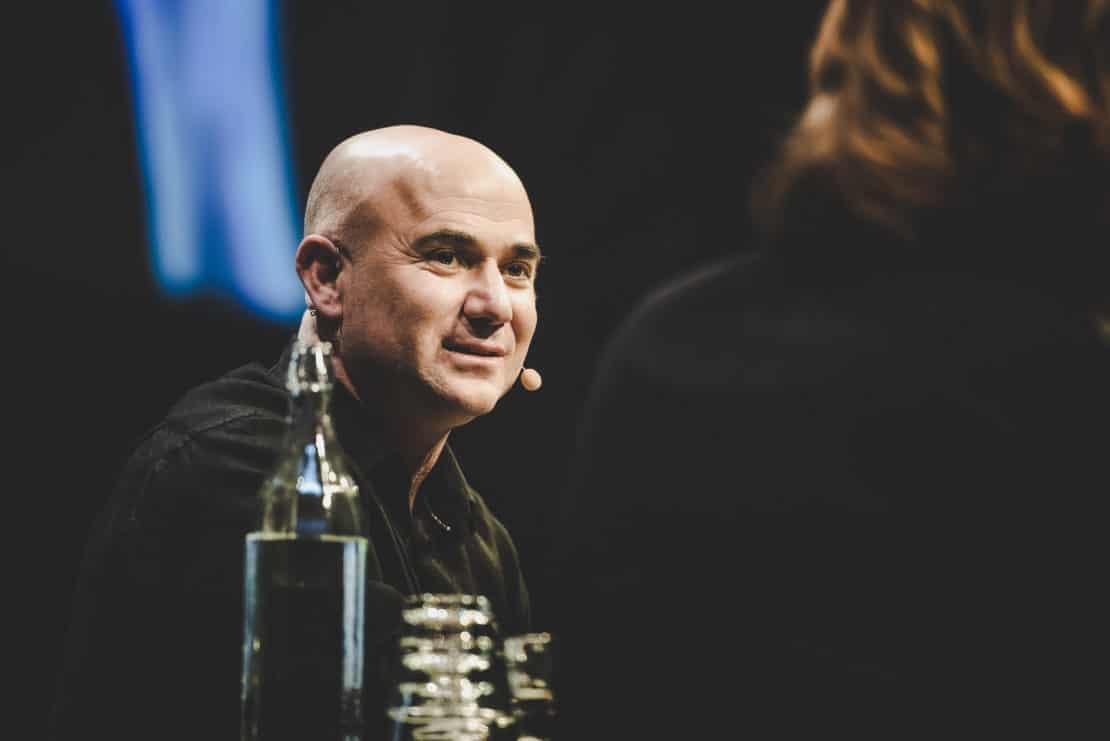1Jun2017
Two hours after her own presentation, Sheila Heen came back to the Nordic Business Forum Sweden stage to interview tennis legend and philanthropist Andre Agassi for his session, “Reflections on Success and Finding Your Purpose.” Following a brief video showcasing Agassi’s tennis career, Heen rewound a bit to hear about his childhood.
“I was the baby of four, and we had one rule in our house – wake up, play tennis, brush your teeth – in that order, and that’s the way it was,” he said.
Growing up in Las Vegas, Nevada, Agassi recalled spending hours on the tennis court every day. His father had always pushed him to work harder, to improve and to be the best. Before he could even walk, Agassi’s father taped a ping pong racket to his hand so he could improve his hand-eye coordination by swatting at a balloon.
As a child, Agassi and his siblings would play at the tennis club in between the time when their mother got off work, and their father went to work. One day when they arrived, his father bet former NFL linebacker Jim Brown that 9-year-old Agassi could beat him in a match. Despite being nervous about how much money was at stake, Agassi beat Brown handily, playing better than he thought he would. Brown told Agassi’s father that he would be the number-one tennis player in the world one day, and his father replied that, of course, he would be.
A vicious cycle of rebellion
At 13 years old, Agassi’s father sent him to the Nick Bollettieri Training Academy in Florida to become an elite tennis player. During his time there, Agassi would work hard, resent it, rebel and then repeat the cycle again and again. He had realized the only way out was to succeed, but he hated it. At age 16, he went pro and left the academy.
“I went pro at 16 and carried that teenage rebellion to a world stage only to be told who I was when I didn’t even know who I was,” he said. “I resented everything that the tennis world meant to me. Those lines were a prison to me; they confined me. But along with them came success, money, freedom. It was a constant conflict that went on inside me.”
He was still learning how to express himself, but being in the public eye meant that people observed and analyzed his every move.
“I had this belief that winning was the answer to all of it and getting to number one in the world would be the payoff,” Agassi said. “I kept pushing through these obstacles and ebbs and flows. After being one of the greatest underachievers, I figured out how to win.”
To quit or rebuild?
When he got the call that he was the number-one tennis player in the world, Agassi said he felt nothing. It was everything he had worked for, but he was still miserable. This sent him into a downward spiral of drugs and unhealthy relationships. He fell from number 1 to 141, and at that point, his coach stepped in and asked him to make a decision – either quit or rebuild.
Agassi began thinking about that fact that while he did not choose this path, neither did many people. We don’t choose our families, or where we’re born, we can’t choose our strengths and weaknesses.
“But just because you don’t choose your life, does that mean you can’t take ownership of it?” Agassi said. From that moment on, he worked to rebuild himself and play for his own reasons.
“Epiphanies don’t change your life. They give you the chance to change your life,” he said. “It all depends on what you do from that day forward.”
Defining success for yourself
Not only did he change his perspective on tennis, but he found a new motivation. He set about developing a $40 million charter school in one of the most economically challenged areas of Las Vegas to help kids who had no other choice. That motivation drove him to succeed.
“I didn’t know if I’d be the best again or if I was any good anymore, but I knew I could be better than I was today,” Agassi said. “I planned my work and then I worked my plan every day, hours of work. I wrote down tangible goals every day and didn’t sleep until I accomplished them.”
He went back to the basics, playing against guys at the lowest ranks. He worked hard to improve a bit more each day, and after a year and a half, he had worked his way back up to winning the French Open. Then another year later, he was number one again.
“[When I became number one again], there was no one else to compare myself to,” Agassi said. “You are the barometer. You end up saying, what do I need to do. You end up needing to figure out how to get better and how to do it every day.”
This time, rather than letting someone else tell him what to strive for, he set the goals himself. Each day, he set out to be better than he was the last. In his time off, he sought to be more efficient than his competitors, to be better prepared for matches.
“Define success for yourself and define it wisely, because if you define it wrong, you can accomplish it and not feel connected with your life,” he said. “If you define it wisely, every day you have the opportunity to be who you want to be and engage with that journey.”
During the question and answer session, Heen relayed a question from the audience about how Agassi stayed buoyant during that tough period between being 141 and climbing back up to number one. He said being clear on how you’re going to choose to engage on a daily basis makes the difficult times less difficult. There will always be struggles, but you have to look at what’s ahead of you rather than what’s behind you.
“I don’t separate the difficult times from the good times,” Agassi said. “If you do it well enough and long enough on a daily basis, it’s this thing called life, and how you choose to go about it is very important to your peace of mind and peace of heart.”
Andre Agassi earned the number-one ranking in the world in tennis on two separate occasions and was the fifth man in tennis history to win every grand slam title. He retired from tennis in 2006 and lives in Las Vegas with his wife, former tennis star Steffi Graf, and their two children.
This article is a part of the Executive Summary of Nordic Business Forum SWEDEN. Get your digital copy of the summary from the link below.


